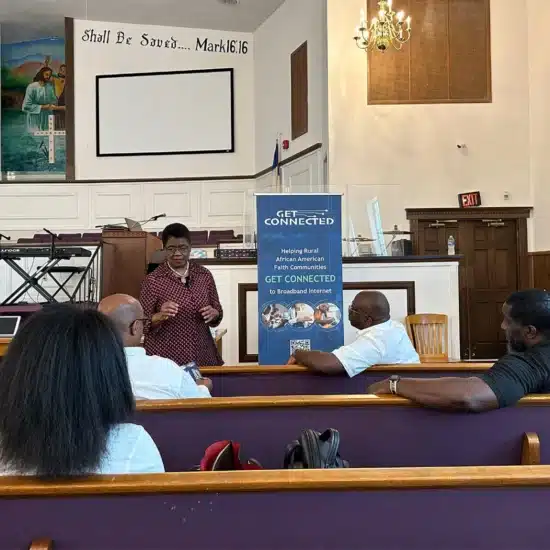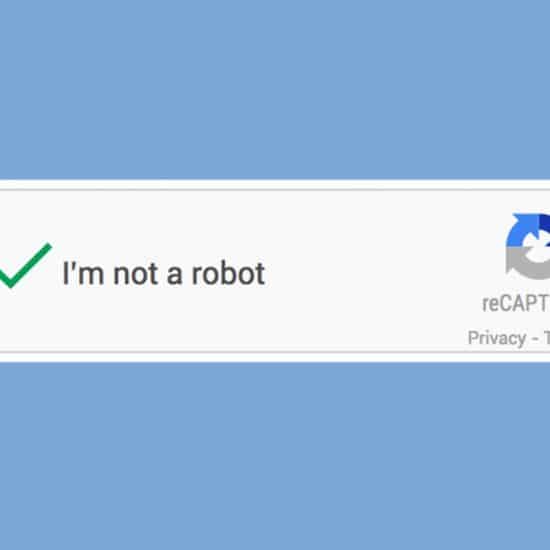(RNS) — Jeremy Smith wanted to talk about Jesus, so he picked up a shovel and headed out to build a tunnel.
A virtual shovel, that is. As both a Christian and a fan of the video game Minecraft, Smith has one foot in two different communities coming into contact more frequently in the fuzzy halls of cyberspace.
And, as a senior writer at the online ministry ChurchMag, Smith uses each of these communities to serve the other. He “vlogs” — creates online videos of himself playing Minecraft — while simultaneously explaining Christian ideology in a series titled “Minecraft Theology.”
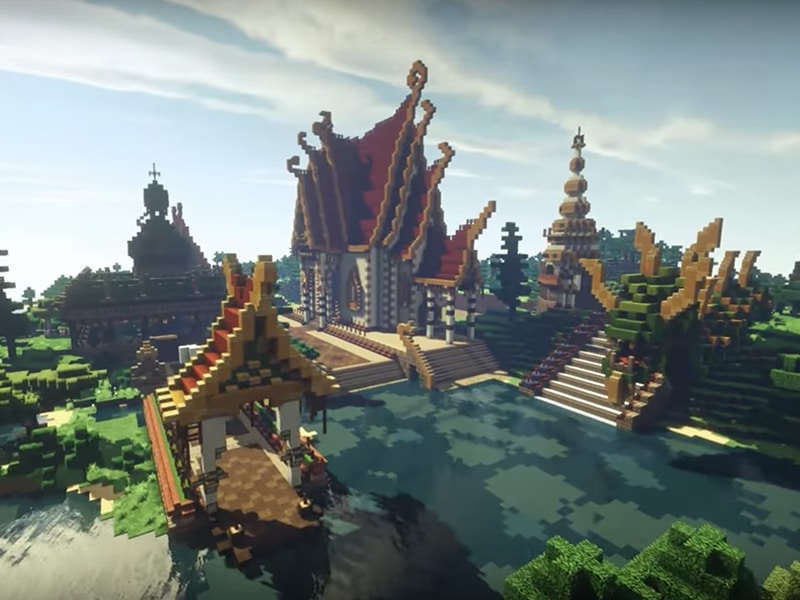 A Thai temple complex created in Minecraft. Screenshot from YouTube“I wanted to look at some of the more basic stuff, some of the core competencies of Christianity,” he said in one of these videos as his Minecraft icon sped across a screen full of the chunky landscape Minecraft allows users to create and navigate via a computer mouse.
A Thai temple complex created in Minecraft. Screenshot from YouTube“I wanted to look at some of the more basic stuff, some of the core competencies of Christianity,” he said in one of these videos as his Minecraft icon sped across a screen full of the chunky landscape Minecraft allows users to create and navigate via a computer mouse.
“Part of the prayer process is admitting that you’ve sinned. If you are of the mindset that you are perfect, then you should probably just go ahead and turn this episode off because I got nothing for you,” he continued. “We have confession when we say ‘yes’ to Jesus and become saved.”
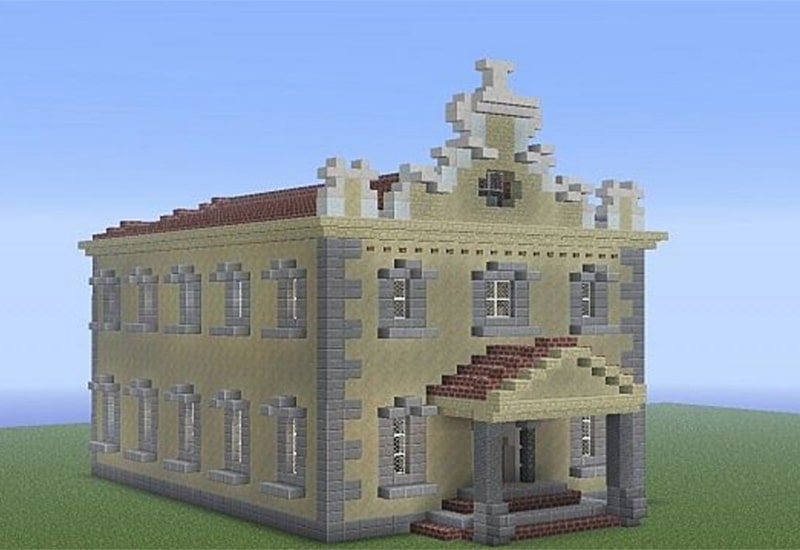 A Minecraft re-creation of the Great Synagogue of Gibraltar. Image by PolishPlayer34In the realm of video games, the 149 views Smith’s video has logged may be far from viral, but Minecraft is becoming what some video game makers hoped Christian-themed games like Catechumen and Adam’s Venture that failed to sell well would become — a tool for exploring and advancing religion among gamers.
A Minecraft re-creation of the Great Synagogue of Gibraltar. Image by PolishPlayer34In the realm of video games, the 149 views Smith’s video has logged may be far from viral, but Minecraft is becoming what some video game makers hoped Christian-themed games like Catechumen and Adam’s Venture that failed to sell well would become — a tool for exploring and advancing religion among gamers.
“Because Minecraft is so open any player can design a world,” said Vincent Gonzalez, a scholar who did his doctoral dissertation on Christian video games. “And whenever things are open, religious people tend to use it to express themselves.”
Ithaca College professor Rachel Wagner sees the use of video games like Minecraft as part of what she calls the “gamification” not only of religion, but of the world. She says religions and video games have several things in common — rules, rituals and a bend toward order and structure.
“Even if they are ‘open’ in the sense of allowing players to construct entire worlds for themselves, as Minecraft does, games always offer spaces in which things make sense, where players have purpose and control,” she said. “For players who may feel that the real world is spinning out of control, games can offer a comforting sense of predictability. They can replace God for some in their ability to promise an ordered world. “
Minecraft is what techie types call a “sandbox” game: It has few rules, so players can dig in anywhere and build what they like. They build with virtual bricks — think digitized Legos — to create bulky buildings, plants, people, anything, in mostly primary colors.
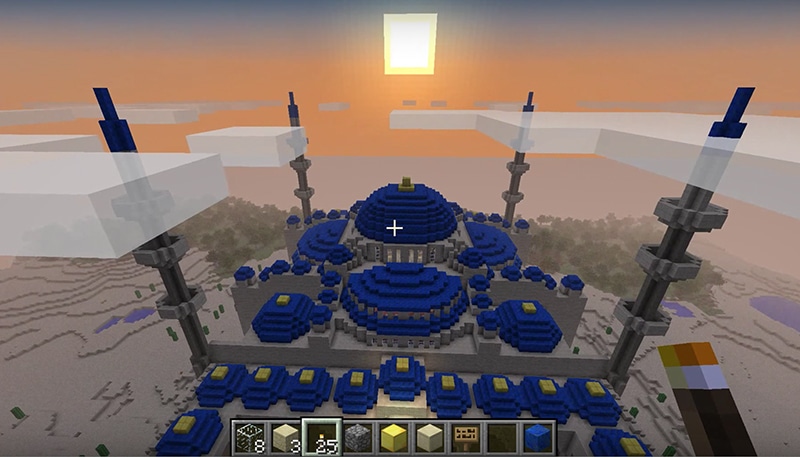 An aerial sunset view of a Blue Mosque creation in Minecraft from the player point of view. Screenshot from YouTubeThere are Minecraft versions where players try to survive or go on adventures of their own devising. And there are versions where people — sometimes children, sometimes adults like Smith — construct homes, buildings, bridges, churches and other houses of worship.
An aerial sunset view of a Blue Mosque creation in Minecraft from the player point of view. Screenshot from YouTubeThere are Minecraft versions where players try to survive or go on adventures of their own devising. And there are versions where people — sometimes children, sometimes adults like Smith — construct homes, buildings, bridges, churches and other houses of worship.
“No one’s pastor is telling them the best way to minister to people is to pretend to be Jesus in a Minecraft world. So the question of why people want to dress up as Jesus and go around in Minecraft is hard to say.”—Vincent Gonzalez, creator of religiousgames.orgSome Minecraft users even “build” their own religious icons. Using blocky “skins” — Minecraft lingo for a character — they create Jesuses, popes, priests, rabbis, angels and more to populate Minecraft worlds everywhere.
But while Minecraft can be used by players of every religion, it seems to be most popular among Christians. Gonzalez, who catalogs religious video games at religiousgames.org, estimates there are about 1,500 religion-themed video games, of which two-thirds are Christian.
Take a peek at Planet Minecraft, a fan site where users can share their creations. It lists 716 “Jesuses” and about 1,000 Catholic priests, but only 58 Jewish rabbis. There is even a Minecraft Richard Dawkins for virtual atheists.
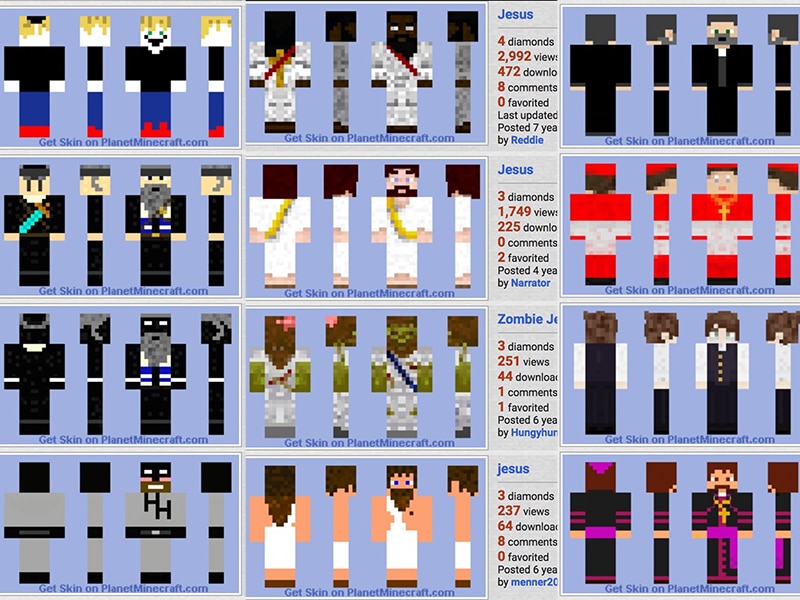 Religious Minecraft skins, or characters, including Jewish options, left column, Jesus variations, center, and priest options, right. Images from PanetMinecraft.comCertainly, not all Minecraft players use religious skins or the churches and other houses of worship they build for some spiritual purpose or for proselytizing. But how they use them is hard to pin down.
Religious Minecraft skins, or characters, including Jewish options, left column, Jesus variations, center, and priest options, right. Images from PanetMinecraft.comCertainly, not all Minecraft players use religious skins or the churches and other houses of worship they build for some spiritual purpose or for proselytizing. But how they use them is hard to pin down.
“No one’s pastor is telling them the best way to minister to people is to pretend to be Jesus in a Minecraft world,” Gonzalez said. “So the question of why people want to dress up as Jesus and go around in Minecraft is hard to say.”
Still, Minecraft and other computer and video games have become so closely aligned with religion in some circles that the American Academy of Religion created a scholars’ group dedicated to its study four years ago.
“For most people, their virtual lives are an extension of their real lives,” said Gregory Grieve, a professor of religious studies at the University of North Carolina at Greensboro who has studied the two decades religious people have engaged in video games. “Among Christians it was a place for proselytizing and a place for meeting people they would not otherwise meet. People who are religious just see these games as an extension of their religious practice.”
Some build houses of worship — YouTube is rife with virtual tours of churches, cathedrals, synagogues and mosques, both real and imaginary. Some build Noah’s Ark or Solomon’s Temple or their own versions of Jerusalem and other “Bible lands.”
The Australian digital design firm Islam Imagined encourages young users to build the “mosque of the future,” and Jewish educators are enlisting Minecraft to visualize Jewish history and culture for students.
Others users create faith-based Minecraft “servers” — private virtual enclaves where members agree to certain rules (no swearing is a common one) and play the game in a form of religious fellowship.
These groups recently became a meme — or joke spread rapidly among internet users — in which users sardonically responded to foul language by uttering different versions of: “Sorry sir, this is a Christian server. No swearing allowed!”
But Eric Dye, editor of ChurchMag, says its Christian-oriented Minecraft server is merely a reflection of how its users see, or want to see, the real world.
“We can build things in it, like themed cities, and there is actually a church,” he said. “It is not like we have church services or anything but it seemed something fun to have. It seemed fitting. That is why you see religion manifested in Minecraft — it is just an extension of people’s interests in what they create.”

